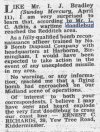-
Welcome to this forum . We are a worldwide group with a common interest in Birmingham and its history. While here, please follow a few simple rules. We ask that you respect other members, thank those who have helped you and please keep your contributions on-topic with the thread.
We do hope you enjoy your visit. BHF Admin Team
You are using an out of date browser. It may not display this or other websites correctly.
You should upgrade or use an alternative browser.
You should upgrade or use an alternative browser.
The True Horrors Of Ww2
- Thread starter Astoness
- Start date
cookie273uk
Gone but not forgotten
Well obviously the Luftwaffe, like the RAF had specific preplanned targets but bombing accuracy was far from a fine art in the early days and the blackout made it even more difficult to spot the target, hence landing on peoples houses. We had one damage our house and we lived in Shirley considered a fairly safe place to be, lived in a Romany caravan in Earlswood whilst our windows and slates replaced and chimney repaired. My sisters and I thought it a great adventure, still had to go to school though. Eric
Bob Davis
Bob Davis
It is interesting that as children we did not have the worry that our parents, or parent, as a lot of us had a Dad away 'at the war' had, and of course we did not really know what that meant, we saw and heard the bombing, we went to the shelters, we saw the damage, but we did not or were not aware of the grief and the worry that the older people felt or thought about. Mum always said thank goodness that was not us as she discussed the latest raid with a neighbour and the closest we got to a bomb was the UXB that fell in Oscott cemetery and the house that was bombed in Goosemoor Lane. It was only as I grew older 1942 onwards that I began to realise what everyone was talking about, I firstly thought that when the raids stopped it was all over, but Dad did not come home, because he was still out there. Parents of teenagers would begin to worry that their son would be called up and of course many of them were, I think the only time when I realised how serious it all was, was when a brother and sister did not come into school one morning and next day as we gathered in the school hall for assembly, the headmistress told us that they would not be in for the rest of the week because their father had been killed in the war and we had to pray for them. Of course as children we knew we would win the war.very close old brit...ive read a lot of peoples memories about the bombs dropping and most of them said the most scary thing was not knowng just where they would land...it was a lottery really
lyn
Thank goodness we are all still here to be able remember it and talk about it.
Bob
Robert Ensor (bob)
master brummie
So my pop to this day swears the Government lied about the death tolls, he was at the Austin's and America sent over engines in crates along with a set of tools, one time when unpacking a crate he came across a US news paper the head line THOUSANDS KILLED IN COVENTRY BOMBINGS he says the deaths we're under reported all over he said the newspapers used for packing told a different story and after a while they stopped use newspapers for packing
Radiorails
master brummie
Of course facts and figures were either distorted or under-estimated here. The Government had a duty to keep up peoples morale. Compare aircraft losses on both sides which were quoted at the time. History has changed to to a more realistic figure. I am sure fairly accurate figures are now known, which contrasts to Eastern Europe where such vast numbers of deaths, from very many reasons, are only guesswork even now.
Nothing has changed even after this time. All politicians manipulate facts and figures for various reasons.
Nothing has changed even after this time. All politicians manipulate facts and figures for various reasons.
Robert Ensor (bob)
master brummie
Radiorails, I am in complete agreement with you but as a Brit I would like to believe those in charge, this whole Nazi deal was one of the best propaganda exercise ever, I have read some numbers for Russian loses and it's incredible how Starlin sacrificed his own people the defense of Starlingrad what a waste of life, if some of the numbers are to be believed he sacrificed more people than Jews murdered by the Nazis
Whilst some folk have commented that V1s never reached as far as the Midlands, that is not quite true. There are the remains of one such missile at RAF Cosford, which landed just outside Newport, on the Staffs / Shropshire border. This was one of the air launched versions fired against Manchester in December 1944. Birmingham was fortunately spared.
oldMohawk
gone but not forgotten
From earlier in the thread and mentions Newport ... 
Some information about V1 attacks outside the London area and the map shows that because they were air launched the impact sites were not accurate.

On Christmas Eve, 1944. 45 missiles air-launched from He-111s of KG53 approximately 40 miles off the east coast between Hornsea and Mablethorpe between 0500 and 0600 aiming at Manchester. A V1 flying bomb struck near the corner of Abbey Hills Road and Warren Lane and 27 people were killed and a further 49 people were injured.
See http://aircrashsites.co.uk/air-raid...e-v1-attack-on-manchester-christmas-eve-1944/
There is an account of the V1 which impacted near Newport in Shropshire.
https://www.bbc.co.uk/shropshire/content/articles/2005/05/27/history_bomb_on_newport_feature.shtml
Last edited:
Radiorails
master brummie
Whereas munitions crossed the English Channel and North Sea, so did this song.
illstonandrobson
New Member
Thank you and welcome Illstonandrobson. We always welcome photographs from private collections to add to our understanding of a locality’s history. Do you know anymore about the bombing ? Presumably it’s WW2, but any idea of a date ? Do you know if there were fatalities ? Hopefully not.
Are you a descendant of the company ?
Many thanks. Viv.
Are you a descendant of the company ?
Many thanks. Viv.
Little bit of information from the web.

 www.illstonandrobson.com
www.illstonandrobson.com

Illston and Robson: A Legacy of Manufacturing High-Quality Linkage Components — Illston & Robson Ltd
Discover the rich history of Illston and Robson, a company with a legacy of manufacturing high-quality linkage components. For decades, we have been synonymous with precision engineering and superior products. Learn about our journey and commitment to excellence.
illstonandrobson
New Member
HiThank you and welcome Illstonandrobson. We always welcome photographs from private collections to add to our understanding of a locality’s history. Do you know anymore about the bombing ? Presumably it’s WW2, but any idea of a date ? Do you know if there were fatalities ? Hopefully not.
Are you a descendant of the company ?
Many thanks. Viv.
the last Robson left in 2003 when the company was bought by Mr & Mrs Reid, the company is still in the ownership of that family now. Someone has already posted the link to our history page, sorry I don't know anything beyond this.
Thanks
Neil
mike reading that article the hopkins family lived in priory road aston where the uxb was found in 2017 on the below thread is a clip of when the army detinated the bomb..bought the area to a standstill and caused chaos on the roads
 birminghamhistory.co.uk
birminghamhistory.co.uk
Priory Road Uxb May 2017
UXB discoverd in priory road aston https://www.birminghammail.co.uk/news/midlands-news/live-updates-second-world-war-13036192 https://www.birminghammail.co.uk/news/midlands-news/live-updates-second-world-war-13036192
 birminghamhistory.co.uk
birminghamhistory.co.uk
Last edited:
Wessex Druid
New Member
Hi Wam,
The doodle bugs never got past London as their engines were designed to cut out when they reached that mileage from their launch base in France. They were so slow that many were destroyed by the RAF
almost as soon as they had crossed the coast. Certainly none reached Birmingham.
Old Boy
Point of order, Old Boy...
My mother, born in Northfield and who spent her childhood living on Weoley Park Road, certainly recalled hearing V1 doodlebugs flying (and cutting out) over Birmingham. Her father worked throughout the war at Longbridge (the Austin Shadow Factory), constructing first Short Stirling, then Avro Lancaster, bombers on 12 hr, 7 day a week, shifts. Her older sister in the ATS, manned an AA gunsite outside London, trying to shoot them down.
Bombing in the UK, including V1s and V2s, was carefully documented at the time and the Forms BC4 and tracings (bomb census records) are now kept in the National Archive, at Kew.
Document HO 198/96, covering Region 9: Midland, Headquarters: Birmingham, dated 24 Dec 1944, lists specifically all the V1 impacts for that region in 1944. There seems to be no equivalent record for that region for V2 impacts - they were all recorded further south and east.
Unfortunately the individual documents are not yet digitised and can only be inspected in Kew, so I can't attach anything, but you can search for yourself:

Bomb Census survey 1940-1945 - The National Archives
1. Why use this guide? This guide will help you to find records at The National Archives of air raids during the Second World War. These records include details of: type and number of bombs dropped location of bombs dropped casualty statistics damage caused to domestic and commercial buildings...
Welcome to the Birmingham History Forum. You have me thinking now and it sounds like what your mom recalls is highly likely to be correct and would certainly be well worth researching more. They have an interesting section on German rockets at Cosford museum, I may pop back and have another look.Point of order, Old Boy...
My mother, born in Northfield and who spent her childhood living on Weoley Park Road, certainly recalled hearing V1 doodlebugs flying (and cutting out) over Birmingham. Her father worked throughout the war at Longbridge (the Austin Shadow Factory), constructing first Short Stirling, then Avro Lancaster, bombers on 12 hr, 7 day a week, shifts. Her older sister in the ATS, manned an AA gunsite outside London, trying to shoot them down.
Bombing in the UK, including V1s and V2s, was carefully documented at the time and the Forms BC4 and tracings (bomb census records) are now kept in the National Archive, at Kew.
Document HO 198/96, covering Region 9: Midland, Headquarters: Birmingham, dated 24 Dec 1944, lists specifically all the V1 impacts for that region in 1944. There seems to be no equivalent record for that region for V2 impacts - they were all recorded further south and east.
Unfortunately the individual documents are not yet digitised and can only be inspected in Kew, so I can't attach anything, but you can search for yourself:

Bomb Census survey 1940-1945 - The National Archives
1. Why use this guide? This guide will help you to find records at The National Archives of air raids during the Second World War. These records include details of: type and number of bombs dropped location of bombs dropped casualty statistics damage caused to domestic and commercial buildings...www.nationalarchives.gov.uk
From what I know it seems the V1’s were in a constant state of development with variations on fuel weight and payload but in general they had a range of around 180 miles plus. So (hypothetically) if launched from occupied Calais and with sufficient altitude (ramjet engines must have a limited altitude?) and speed it would be doable.
I would certainly like to hear what the other members think about this.
I do think that information on the impact of the war in the Midlands in terms of WWII bombing seems thin on the ground, maybe due to reporting restrictions. There are a few bomb maps, but not of good quality. A couple I have seen are at odds with witness accounts and evidence on the ground.
devonjim
master brummie
I know little of the range of V1's etc but I do know that in 1944 the government were moving children out of London to Birmingham to put them beyond their range. I have personal memories of this influx.Welcome to the Birmingham History Forum. You have me thinking now and it sounds like what your mom recalls is highly likely to be correct and would certainly be well worth researching more. They have an interesting section on German rockets at Cosford museum, I may pop back and have another look.
From what I know it seems the V1’s were in a constant state of development with variations on fuel weight and payload but in general they had a range of around 180 miles plus. So (hypothetically) if launched from occupied Calais and with sufficient altitude (ramjet engines must have a limited altitude?) and speed it would be doable.
I would certainly like to hear what the other members think about this.
I do think that information on the impact of the war in the Midlands in terms of WWII bombing seems thin on the ground, maybe due to reporting restrictions. There are a few bomb maps, but not of good quality. A couple I have seen are at odds with witness accounts and evidence on the ground.
oldbrit
OldBrit in Exile
The V1 I remember counting to 10, then boom in Yardley Brum, was I dreaming?Point of order, Old Boy...
My mother, born in Northfield and who spent her childhood living on Weoley Park Road, certainly recalled hearing V1 doodlebugs flying (and cutting out) over Birmingham. Her father worked throughout the war at Longbridge (the Austin Shadow Factory), constructing first Short Stirling, then Avro Lancaster, bombers on 12 hr, 7 day a week, shifts. Her older sister in the ATS, manned an AA gunsite outside London, trying to shoot them down.
Bombing in the UK, including V1s and V2s, was carefully documented at the time and the Forms BC4 and tracings (bomb census records) are now kept in the National Archive, at Kew.
Document HO 198/96, covering Region 9: Midland, Headquarters: Birmingham, dated 24 Dec 1944, lists specifically all the V1 impacts for that region in 1944. There seems to be no equivalent record for that region for V2 impacts - they were all recorded further south and east.
Unfortunately the individual documents are not yet digitised and can only be inspected in Kew, so I can't attach anything, but you can search for yourself:

Bomb Census survey 1940-1945 - The National Archives
1. Why use this guide? This guide will help you to find records at The National Archives of air raids during the Second World War. These records include details of: type and number of bombs dropped location of bombs dropped casualty statistics damage caused to domestic and commercial buildings...www.nationalarchives.gov.uk
Well that delay then boom was certainly the signature the V1’s had.The V1 I remember counting to 10, then boom in Yardley Brum, was I dreaming?
Wessex Druid
New Member
Welcome to the Birmingham History Forum. You have me thinking now and it sounds like what your mom recalls is highly likely to be correct and would certainly be well worth researching more. They have an interesting section on German rockets at Cosford museum, I may pop back and have another look.
From what I know it seems the V1’s were in a constant state of development with variations on fuel weight and payload but in general they had a range of around 180 miles plus. So (hypothetically) if launched from occupied Calais and with sufficient altitude (ramjet engines must have a limited altitude?) and speed it would be doable.
V1s were pulsejets, not ramjets. A pulsejet works by using a series of explosions to produce thrust. It consists of a series of louvers (flap-like valves) in the inlet, which open and close rapidly, allowing air to be drawn in and then expelled by the explosions, creating a continuous, pulsating thrust, hence the nickname 'buzz bombs'. The V1's pulsejet engine was relatively simple and inexpensive to produce and most efficient at lower altitudes.
Ramjets, by comparison, work better at higher altitudes and rely on high speed to compress the incoming air, which is then mixed with fuel and ignited, generating a high-pressure stream of exhaust that propels the vehicle forward. They are most efficient when the incoming air is already at a significant speed; they tend to be used in conjunction with other propulsion to get them to that velocity. (V2s, were of course rockets.)
But interesting that you called her 'Mom' - as that's how she always refered to herself...
PS - thanks for the welcome!
Last edited:








